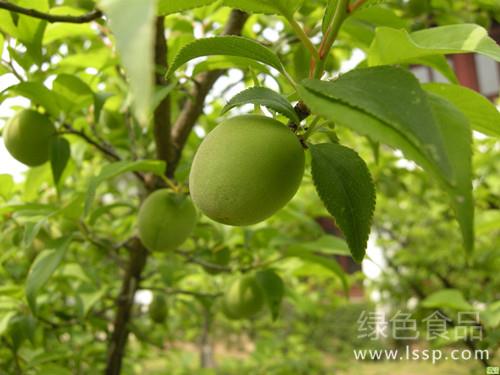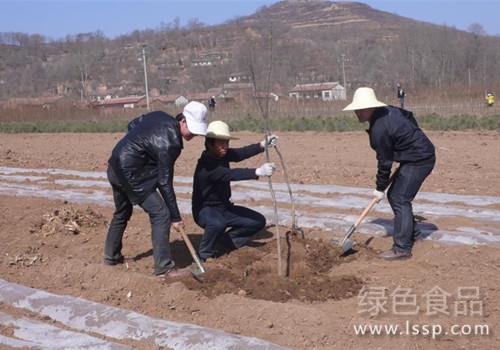High-yield and high-yield cultivation techniques of green plum with pollination trees and blooming bee
Green plum originated in China, in order to make green plum high yield and high quality, it is necessary to have these conditions: suitable climatic conditions and cultivation environment, selection of excellent varieties, reasonable collocation of pollination trees, bee release at flowering stage, scientific cultivation.

Green plum
1. Select the suitable cultivation environment: green plum is suitable for warm climate and cold-tolerant. The flowering stage of green plum is frozen at-8 ℃ ~-9 ℃, the cold tolerance of young fruit is weakened, and the cold is frozen at-3 ℃ ~-5 ℃. Generally, green plum bases are established in flat mountain nests or halfway hillsides with good light conditions, no pollution, sufficient water sources, deep, fertile, moist and well-drained soil.
2. Planting high-yield and high-quality varieties, reasonable collocation, releasing bees during flowering: at present, the main excellent varieties cultivated by green plum are peach plum, Li plum, white plum, soft branch big grain plum and so on. When planting, in addition to selecting these varieties, they should be pollinated according to a certain proportion with excellent varieties with the same or similar flowering period, such as 80% Mel 90% Li Mei, 10% Mel 20% Peach Mei, or 70% Peach Plum with 30% Li Mei, or 60% Li Mei with 40% Peach Plum and other pollination combinations. If the existing pollination varieties in the original green plum orchard are insufficient, the high grafting method should be adopted and a certain proportion of pollination trees should be replaced. In addition to pollination trees with the same or similar flowering period, bees should be released at the flowering stage. Generally, there are two groups of bees per mu of green plum orchard.
3. Rational planting: 40 trees per mu in mountainous and thin land, and 40 trees per mu in flat land and fertile land. Interplant and re-pruning should be carried out in time for the original green plum orchards which are too dense, cover each other and affect photosynthesis.
4. Strengthen the management of fertilizer and water: the fertilization of young green plum trees should be based on the principle of applying thin and quick-acting fertilizer frequently. The fruiting tree is applied three times a year, the first time after fruit picking, the second time before flowering, and the third time in the small fruit stage after flowering. Before flowering, high-quality organic fertilizer is applied, mainly human and animal manure, cake fertilizer and farm manure, which should account for 2% of the annual fertilizer application. At flower bud stage and small fruit stage, foliar fertilizer such as potassium dihydrogen phosphate was applied outside the root, combined with appropriate amount of lime, calcium supplement, and neutralization of soil pH. In florescence and young fruit stage, if there is dry weather, it should be irrigated in time; in full bloom, in case of thick fog and frost, clear water should be sprayed in the morning to wash fog and frost to prevent female flower stigma from drying, which is helpful to improve the rate of fruit setting. Cover with a layer of 3-6cm thick fresh soil after fruit harvest every year to protect the roots and promote the growth of new roots.
5. Pruning and shaping: green plum likes light, pruning and shaping in time will help to form a natural happy crown and promote ventilation and light transmission of the crown. Shaping starts from the young tree, leaving the trunk height about 60cm to trim the top, leaving three main branches in different directions with a bifurcation angle of 40-50 degrees, and the main branch is coring again at 50-60cm to promote its branching, and each main branch leaves 3 branches, so that it basically forms a crown skeleton, and then allows it to continue to branch and form a natural happy crown. The fruiting tree should be pruned in time, the first pruning after spring shoot germination or fruit harvest in the small fruit stage, and the second pruning before flowering, cutting off shady branches, withered branches, weak branches, pest branches and long branches, so as to promote the ventilation and light of the crown, facilitate the concentration of nutrients, and reduce the damage of diseases and insect pests.
6. strengthen the prevention and control of diseases and insect pests:
The main results are as follows: (1) insect pests: small fruit stage and spring shoot sprouting stage, focusing on the control of new shoot pests of aphids, it can be used to control aphid pests by 500x, 1500Mel 2000 times, 3000 times or 1000 times. Pyrethroids and other pesticides are used to control all kinds of leaf-eating insects in summer.
(2) Diseases: 0.1% Mel 0.2% borax was sprayed once in flower bud stage and small fruit stage to control green plum gum disease. New shoot stage, green plum expansion stage, timely prevention and control of scab. The commonly used pesticides are 500 times of aerobic copper chloride, 600 times of copper, 800 times of thiophanate, 800 times of thiophanate. Prevention and control of diseases and insect pests, combined with winter garden cleaning, trunk whitening, spraying turpentine mixture or stone sulfur mixture to eliminate the source of overwintering diseases and insect pests.
7. Harvest: during the mature period of green plum, in order to improve the quality and yield of green plum, adjust the balance of physiological function of the tree, and restore the tree potential in time, the fruit should be harvested by stages, first ripe first, and harvested in 3 batches of 2 Mel, so as to gradually reduce the tree burden and prevent moisture imbalance. At the same time, careful picking should be taken to prevent breaking of plum branches and fruit scraping.
- Prev

Eight key points should be paid attention to in the cultivation of high-yield walnut with symptomatic application of technology.
Eight key points should be paid attention to in the cultivation of high-yield walnut with symptomatic application of technology.
- Next

What if the leaves of Ping an tree droop or dry up?
Analysis and treatment of the sagging leaves of Ping an tree: pour some water on the leaves, cover the packaging film from bottom to top, seal the top, and the sky is good, mainly because the temperature is too low, and then it is not watered. This is how some flower friends share it. The withering of leaves is the lack of trace elements.
Related
- Fuxing push coffee new agricultural production and marketing class: lack of small-scale processing plants
- Jujube rice field leisure farm deep ploughing Yilan for five years to create a space for organic food and play
- Nongyu Farm-A trial of organic papaya for brave women with advanced technology
- Four points for attention in the prevention and control of diseases and insect pests of edible fungi
- How to add nutrient solution to Edible Fungi
- Is there any good way to control edible fungus mites?
- Open Inoculation Technology of Edible Fungi
- Is there any clever way to use fertilizer for edible fungus in winter?
- What agents are used to kill the pathogens of edible fungi in the mushroom shed?
- Rapid drying of Edible Fungi

